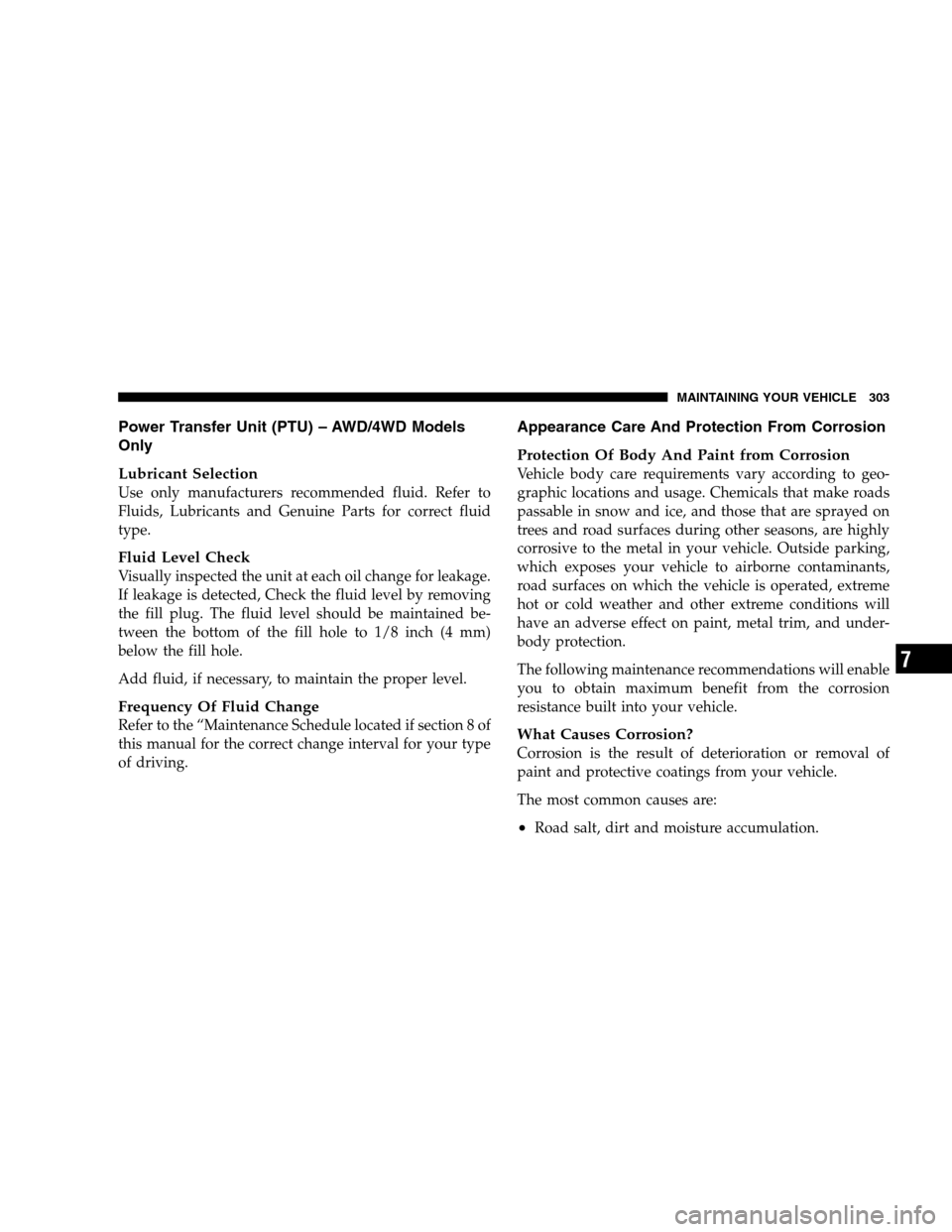Page 278 of 360

▫Cooling System.......................294
▫Hoses And Vacuum/Vapor Harnesses.......298
▫Fuel System Connections................298
▫Brake System........................298
▫Automatic Transaxle (Cvt)...............301
▫Manual Transaxle.....................302
▫Rear Drive Assembly (Rda )–
AWD/4WD Models Only...............302
▫Power Transfer Unit (Ptu) –
AWD/4WD Models Only...............303
▫Appearance Care And Protection
From Corrosion......................303
�Fuses/Integrated Power Module (IPM)......307
�Vehicle Storage........................310
�Replacement Bulbs.....................310
�Bulb Replacement......................311
▫Headlights/Front Parking/
Front Turn Signal.....................311
▫Fog Lights..........................311
▫Tail Lights, Rear Turn Signals And
Backup Lights — Replacement............312
▫License Lights........................314
▫Center High-Mounted Stoplight...........315
�Fluids And Capacities...................316
�Fluids, Lubricants And Genuine Parts.......317
▫Engine.............................317
▫Chassis............................318
278 MAINTAINING YOUR VEHICLE
Page 302 of 360

Manual Transaxle
Lubricant Selection
Use only manufacturers recommended transmission
fluid. Refer to Fluids, Lubricants and Genuine Parts for
correct fluid type.
Fluid Level Check
Check the fluid level by removing the fill plug. The fluid
level should be between the bottom of the fill hole and a
point not more that 3/16” (4.7 mm) below the bottom of
the hole.
Add fluid, if necessary, to maintain the proper level.
Frequency Of Fluid Change
Under normal operating conditions, the fluid installed at
the factory will give satisfactory lubrication for the life of
the vehicle. Fluid changes are not necessary unless the
following conditions exist:
•The lubricant has become contaminated with water. If
contaminated with water, the fluid should be changed
immediately.
•If severe usage has occurred, refer to Maintenance
Schedule “B” in Section 8 of this manual.
Rear Drive Assembly (RDA )– AWD/4WD Models
Only
Lubricant Selection
Use only manufacturers recommended fluid. Refer to
Fluids, Lubricants and Genuine Parts for correct fluid
type.
Fluid Level Check
Visually inspected the unit at each oil change for leakage.
If leakage is detected, Check the fluid level by removing
the fill plug. The fluid level should be maintained be-
tween the bottom of the fill hole to 1/8 inch (4 mm)
below the fill hole.
Add fluid, if necessary, to maintain the proper level.
Frequency Of Fluid Change
Refer to the “Maintenance Schedule located if section 8 of
this manual for the correct change interval for your type
of driving.
302 MAINTAINING YOUR VEHICLE
Page 303 of 360

Power Transfer Unit (PTU) – AWD/4WD Models
Only
Lubricant Selection
Use only manufacturers recommended fluid. Refer to
Fluids, Lubricants and Genuine Parts for correct fluid
type.
Fluid Level Check
Visually inspected the unit at each oil change for leakage.
If leakage is detected, Check the fluid level by removing
the fill plug. The fluid level should be maintained be-
tween the bottom of the fill hole to 1/8 inch (4 mm)
below the fill hole.
Add fluid, if necessary, to maintain the proper level.
Frequency Of Fluid Change
Refer to the “Maintenance Schedule located if section 8 of
this manual for the correct change interval for your type
of driving.
Appearance Care And Protection From Corrosion
Protection Of Body And Paint from Corrosion
Vehicle body care requirements vary according to geo-
graphic locations and usage. Chemicals that make roads
passable in snow and ice, and those that are sprayed on
trees and road surfaces during other seasons, are highly
corrosive to the metal in your vehicle. Outside parking,
which exposes your vehicle to airborne contaminants,
road surfaces on which the vehicle is operated, extreme
hot or cold weather and other extreme conditions will
have an adverse effect on paint, metal trim, and under-
body protection.
The following maintenance recommendations will enable
you to obtain maximum benefit from the corrosion
resistance built into your vehicle.
What Causes Corrosion?
Corrosion is the result of deterioration or removal of
paint and protective coatings from your vehicle.
The most common causes are:
•Road salt, dirt and moisture accumulation.
MAINTAINING YOUR VEHICLE 303
7
Page 308 of 360
Cavity Cartridge
FuseMini
FuseDescription
1 Empty Empty
2 15 Amp
Lt. BlueAWD/4WD ECU
Feed
3 10 Amp
RedCHMSL Brake Switch
Feed
4 10 Amp
RedIgnition Switch Feed
5 20 Amp
YellowTrailer Tow
6 10 Amp
RedIOD Sw/Pwr Mir/
Ocm Steering Cntrl
Sdar/Hands Free
Phone
7 30 Amp
GreenIOD Sense1
8 30 Amp
GreenIOD Sense2
9 40 Amp
GreenPower SeatsCavity Cartridge
FuseMini
FuseDescription
10 20 Amp
YellowCCN Power Locks
11 15 Amp
Lt BluePower Outlet
12 20 Amp
YellowIgn Run/Acc Inverter
13 20 Amp
YellowPwr run/Acc Outlet
RR
14 10 Amp
RedIOD CCN/ Interior
Lighting
15 40 Amp
GreenRAD Fan Relay Bat-
tery Feed
16 15 Amp
Lt. BlueIGN Run/Acc Cigar
Ltr/Sunroof
17 10 Amp
RedIOD Feed Mod-Wcm
18 40 Amp
GreenASD Relay Contact
PWR Feed
19 20 Amp
YellowPWR Amp 1 & Amp
2 Feed
308 MAINTAINING YOUR VEHICLE